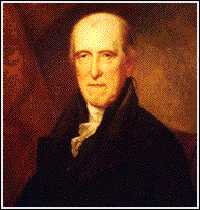TocDocuments
Essays
Biographies
Presidents
About
Project
Awards
The team
Contributions
Info
Disclaimer
Copyright
Sponsoring
Navigation
Guestbook
Printing
A Biography of Jared Ingersoll 1749-1822
*** Quote ***
 The son of Jared Ingersoll, Sr., a British colonial official and later prominent Loyalist, Ingersoll
was born at New Haven, CT, in 1749. He received an excellent education and graduated from
Yale in 1766. He then oversaw the financial affairs of his father, who had relocated from New
Haven to Philadelphia. Later, the youth joined him, took up the study of law, and won admittance
to the Pennsylvania bar.
The son of Jared Ingersoll, Sr., a British colonial official and later prominent Loyalist, Ingersoll
was born at New Haven, CT, in 1749. He received an excellent education and graduated from
Yale in 1766. He then oversaw the financial affairs of his father, who had relocated from New
Haven to Philadelphia. Later, the youth joined him, took up the study of law, and won admittance
to the Pennsylvania bar.
In the midst of the Revolutionary fervor, which neither father nor son shared, in 1773, on the advice of the elder Ingersoll, Jared, Jr., sailed to London and studied law at the Middle Temple. Completing his work in 1776, he made a 2-year tour of the Continent, during which time for some reason he shed his Loyalist sympathies.
Returning to Philadelphia and entering the legal profession, Ingersoll attended to the clients of one of the city's leading lawyers and a family friend, Joseph Reed, who was then occupied with the affairs of the Supreme Executive Council of Pennsylvania. In 1781 Ingersoll married Elizabeth Pettit (Petit). The year before, he had entered politics by winning election to the Continental Congress (1780-81).
Although Ingersoll missed no sessions at the Constitutional Convention, had long favored revision of the Articles of Confederation, and as a lawyer was used to debate, he seldom spoke during the proceedings.
Subsequently, Ingersoll held a variety of public positions: member of the Philadelphia common council (1789); attorney general of Pennsylvania (1790-99 and 1811-17); Philadelphia city solicitor (1798-1801); U.S. District Attorney for Pennsylvania (1800-01); and presiding judge of the Philadelphia District Court (1821-22). Meantime, in 1812, he had been the Federalist Vice-Presidential candidate, but failed to win election.
While pursuing his public activities, Ingersoll attained distinction in his legal practice. For many years, he handled the affairs of Stephen Girard, one of the nation's leading businessmen. In 1791 Ingersoll began to practice before the U.S. Supreme Court and took part in some memorable cases. Although in both Chisholm v. Georgia (1792) and Hylton v. United States (1796) he represented the losing side, his arguments helped to clarify difficult constitutional issues. He also represented fellow-signer William Blount, a senator, when he was threatened with impeachment in the late 1790s.
Ingersoll's long career ended in 1822, when he died less than a week after his 73d birthday. Survived by three children, he was buried in the cemetery of Philadelphia's First Presbyterian Church.
Text copied from National Archives and Records Administration The Founding Fathers Page
for From Revolution to Reconstruction - an .HTML project.
Last update: 2025-4-16 time: 04:08
© 1994- 2007. All rights reserved.
Department of Humanities Computing